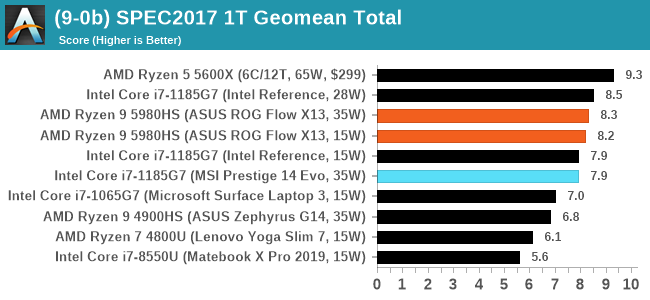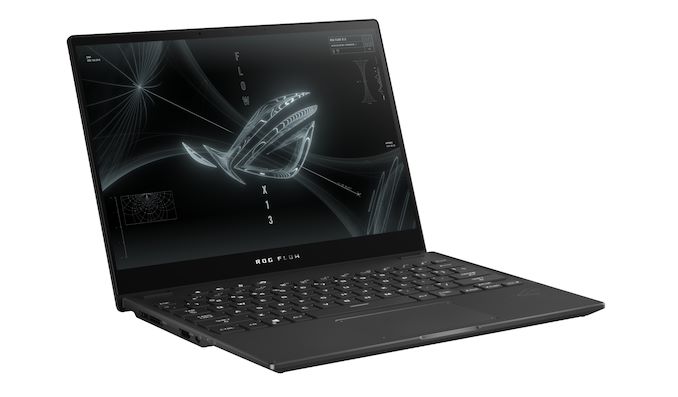AMD Ryzen 9 5980HS Cezanne Review: Ryzen 5000 Mobile Tested
by Dr. Ian Cutress on January 26, 2021 9:00 AM EST- Posted in
- CPUs
- AMD
- Vega
- Ryzen
- Zen 3
- Renoir
- Notebook
- Ryzen 9 5980HS
- Ryzen 5000 Mobile
- Cezanne
Focusing on Premium Experiences
The issue with AMD’s notebook strategy through the 2010s was that most users saw the brand as a budget implementation, with low performance and low specifications. Both AMD and its OEM partners were complicit in assisting this projection, using 1366x768 TN screens and slow mechanical hard drives. There were a number of negative feedback loops preventing a nice AMD mobile system from hitting the market, and the only key design wins were from mass corporate sales. With the launch of the first Ryzen Mobile towards the end of the decade, AMD finally had a performance product worthy of attention, and the company has had a steady improvement generation-on-generation, convincing its OEM partners to come along and take advantage of the performance uplift for their customers.
AMD’s historic lows in that 2010 decade were performance, specifications, and battery life. With Ryzen 4000 Mobile, from last generation, AMD had a product that could dispel all those assumptions, and we saw critical acclaim put upon devices like the Lenovo Slim 7 Yoga, and the ASUS Zephyrus G14. From our review of the new generation today, Ryzen 5000 Mobile, the whole strategy that AMD is playing has finally come into focus.
AMD stated that the new generation Ryzen 5000 Mobile processors were in the lab and up-and-running only two months after Ryzen 4000 Mobile launched. AMD made both sets of processors pin-compatible, allowing OEM partners to build designs that could be used for either processor family. The key here that I’ve realized is that AMD’s ultimate goal with these was to build a strong Ryzen 5000 Mobile family, and Ryzen 4000 Mobile was an option for partners to take baby steps, but the main goal was Ryzen 5000, with Zen 3. AMD’s statement of already having over 150+ system designs in the works with Ryzen 5000 Mobile, another +50% over the previous generation, along with this strategy of having a regular predictable cadence of products through re-use of different hardware elements showcases why Ryzen 5000 Mobile is important to the company. With AMD’s recent supply issues as well, we’re of the opinion that AMD has been stockpiling these Ryzen 5000 Mobile processors in order to enable a strong Q1 and Q2 launch of the platform with stock for all OEMs.
What we tested today is one of the AMD flagships for launch, the Ryzen 9 5980HS inside the ASUS ROG Flow X13. This is a sub-16mm ultraportable gaming laptop with a mid-range discrete GPU installed, an impressive 4K 16:10 Pantone certified IPS display, 32GB LPDDR4X memory and a 1 TB NVMe SSD. It also has an executive feel and design, indicating that both AMD and ASUS want to take this platform to its most premium customers. We’re leaving a full review of the laptop itself for a later date, let us focus on the performance of the processor inside.
The jump from Zen 2 to Zen 3 in the mobile space for AMD is more than just putting in the new cores. The cache adjustment from a split 4+4 MB L3 cache to a unified 16 MB L3 cache enables a better effective latency and less reliance on constantly going out to main memory – AMD is also aggressive on the L3 prefetching policies to drive performance. We can see that the single 8-core CCX has low core-to-core communication latency showcasing that enthusiast level workloads will benefit in more ways than one.
AMD is also piling on improvements to help with power, such as enabling different per-core voltage levels and a more efficient memory controller. Per-core voltage control is something that every modern CPU has to have (or at least islands of CPUs) in order to get the best battery performance. AMD is pairing this with its CPPC2 support, and users will benefit from very quick idle-to-turbo performance for immediate responsiveness.

For our benchmark suite, almost all of our benchmarks show an uplift for the new Ryzen 5000 Mobile series, some considerably so: our compile benchmark is +12%, Corona rendering is +18%, Dolphin emulation +17%, NAMD +8%, Blender +6%. To our surprise our SPEC2006 1T benchmark is +32%, accelerated considerably by the 16 MB L3 cache, but also because these CPUs also support a higher instantaneous power turbo modes than the previous generation. This enables some competitive performance numbers against Intel’s Tiger Lake platform in single thread focused tests (AMD wins on multithread quite easily).
All of these core updates, as well as design wins enabling better hardware under the hood, put AMD’s Ryzen 5000 Mobile series in good stead to power a generation of machines especially as more and more of us work from home. When Intel was in a period of high demand through 2018 and 2019, Intel focused on premium solutions to make the most revenue - Intel’s financials last week showed that the company was selling more and more education-focused low-end notebooks and Chromebooks, now that demand had reduced. We can apply something similar to AMD's current situtation - AMD’s silicon is in high demand for 2021, and so AMD’s target this year would appear to be more mid-range, premium commercial, and enthusiast machines. To reaffirm this, AMD has also promised that we will see notebooks this year paired with the most powerful mobile graphics cards, enabling high-performance gamers to move to AMD. No doubt we will have a number pass through our hands through the year, especially as they hit the shelves starting February.












218 Comments
View All Comments
Ptosio - Tuesday, January 26, 2021 - link
ARM is not some magic silver bullet - MediaTech has vast experience with ARM but are their chromebook chips any way close to Apple M1? (or Zen3 for that matter?)And remember AMD is yet to get acess to the same TSMC process as Apple - maybe once they're on par, large part of that efficiency advantage dissapears?
ABR - Wednesday, January 27, 2021 - link
AMD has K12, which Jim Keller also worked on, waiting in the wings. Most assuredly they have continued developing it. Whether it will play in the same league with M1 remains to be seen, but they also have the graphics IP to go with it so they could likely come out with a strong offering if it comes to that. Not sure what Intel will do..Deicidium369 - Wednesday, January 27, 2021 - link
ancient design, far exceeded by even 10 year old ARM designs.Spunjji - Thursday, January 28, 2021 - link
You say some really silly thingsSpunjji - Thursday, January 28, 2021 - link
"Apple will outclass everything x86 once they introduce their second gen silicon with much higher core count and other architectural improvements."I'll believe it when I see it. Their first move was far better than expected, but it doesn't come close to justifying the claims you're making here.
Glaurung - Saturday, January 30, 2021 - link
M1 is Apple's replacement for ultra-low power, nominal 15w Intel chips. Later this year we will see their replacement for higher powered (35-65w) Intel chips. Nobody knows what those chips will be like yet, but it's pretty obvious they'll have 8 or 16 performance cores instead of just 4, with a similar scale up of the number of GPU cores. They'll add the ability to handle more than 16gb and two ports, and they will put it in their high end laptops and imac desktops. Potentially also on the menu would be a faster peak clock rate. That's not an "I'll believe it when I see it," that's a foregone conclusion. Also a foregone conclusion: next year they will have an even faster core with even better IPC to put in their phones, tablets, and computers.As of last year, Apple's chips had far better IPC and performance per watt than anything Intel or AMD could make, and they only fell short on overall performance due to only having 4 performance cores in their ultra-low power chips.
(For the record, I use Windows. But there's no denying that Apple is utterly dominating in the contest to see who can make the fastest CPUs)
GeoffreyA - Sunday, January 31, 2021 - link
Apple will release faster cores but so will AMD. And now that they've got an idea of what Apple's design is capable of, I'm pretty sure they could overtake it, if they wanted to.GeoffreyA - Sunday, January 31, 2021 - link
As much as I hate to say it, the M1 could be analogous to Core and K8 in the Netburst era. The return to lower clock speeds, higher IPC, and wider execution. Having Skylake and Sunny C. as their measure, AMD produced so and so (and brilliant stuff too, Zen 3 is). Perhaps the M1 will recalibrate the perf/watt measure, like Conroe did, like the Athlon 64 did.I've got a feeling, too, that ARM isn't playing the role in the M1 that people are thinking. It's possible the difference in perf/watt between Zen 3 and M1 is due not to x86 vs. ARM but rather the astonishing width of that core, as well as caches. How much juice ARM is adding, I doubt whether we can say, unless the other components were similar. My belief, it isn't adding much.
Farfolomew - Thursday, February 4, 2021 - link
Very nice comment, and this little thread is a really fascinating read. I've not thought of the comparisons of the P4 -> Core2Duo Mhz regression, but I really think you're on to something here. The thing is, this isn't anything new with M1, Apple has been doing it since the A9 back in 2015, when it finally had IPC parity with the Core M chips. The M1 is just the evolution and scaling up to that of an equivalent TDP laptop chip that Intel has been producing.So the question, then, is, if it's not the "ARM" architecture giving the huge advantages, why haven't we seen a radical shift in the x86 technology back to ultra wide cores, and caches? Or maybe we are, incrementally, with Ice/Tiger Lake, and Zen 2/3/4?
Very fascinating times!
GeoffreyA - Sunday, February 7, 2021 - link
"Or maybe we are, incrementally, with Ice/Tiger Lake, and Zen 2/3/4?"I think that sums it up. As to why their scaling is going at a slower rate, there are a few possible explanations. Likely, truth is somewhere in between.
Firstly, AMD and Intel have aimed for high-frequency designs, which is at loggerheads with widening of a core. Then, AMD has been targeting Haswell (and later) perf/watt with Zen. When one's measure is such, one won't go much beyond that (Zen 2 and 3 did, but there's still juice in the tank). Lastly, it could be owing to the main bottleneck in x86: the variable-length instructions, which make parallel decoding difficult. Adding more decoders helps but causes power to go up. So the front end could be limiting how much we can widen our resources down the line.
Having said that, I still think that AMD's ~15% IPC increase each year has been impressive. "The stuff of legend." Intel, back when it was leading, had us believe such gains were impossible. It's going to be some interesting years ahead, watching the directions Intel, Apple, and AMD take. I'm confident AMD will keep up the good work.